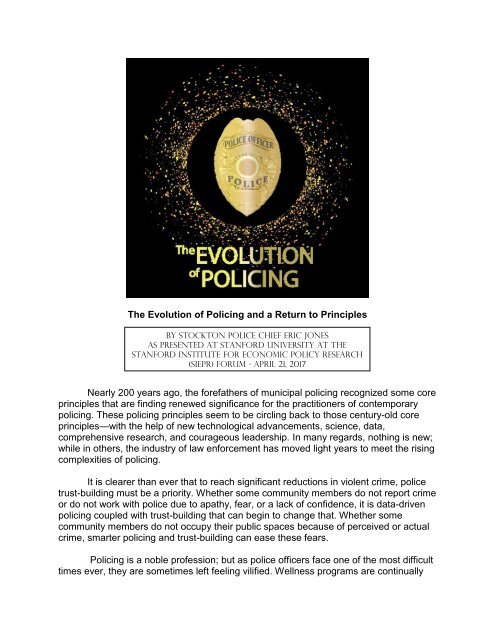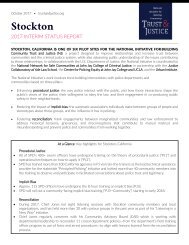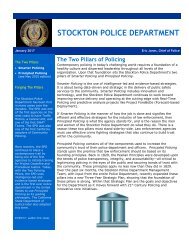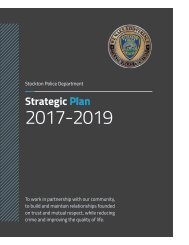The Evolution of Policing 2017 by Chief Eric Jones
Create successful ePaper yourself
Turn your PDF publications into a flip-book with our unique Google optimized e-Paper software.
<strong>The</strong> <strong>Evolution</strong> <strong>of</strong> <strong>Policing</strong> and a Return to Principles<br />
By Stockton Police <strong>Chief</strong> <strong>Eric</strong> <strong>Jones</strong><br />
As presented at Stanford University at the<br />
Stanford Institute for Economic Policy Research<br />
(SIEPR) Forum - April 21, <strong>2017</strong><br />
Nearly 200 years ago, the forefathers <strong>of</strong> municipal policing recognized some core<br />
principles that are finding renewed significance for the practitioners <strong>of</strong> contemporary<br />
policing. <strong>The</strong>se policing principles seem to be circling back to those century-old core<br />
principles—with the help <strong>of</strong> new technological advancements, science, data,<br />
comprehensive research, and courageous leadership. In many regards, nothing is new;<br />
while in others, the industry <strong>of</strong> law enforcement has moved light years to meet the rising<br />
complexities <strong>of</strong> policing.<br />
It is clearer than ever that to reach significant reductions in violent crime, police<br />
trust-building must be a priority. Whether some community members do not report crime<br />
or do not work with police due to apathy, fear, or a lack <strong>of</strong> confidence, it is data-driven<br />
policing coupled with trust-building that can begin to change that. Whether some<br />
community members do not occupy their public spaces because <strong>of</strong> perceived or actual<br />
crime, smarter policing and trust-building can ease these fears.<br />
<strong>Policing</strong> is a noble pr<strong>of</strong>ession; but as police <strong>of</strong>ficers face one <strong>of</strong> the most difficult<br />
times ever, they are sometimes left feeling vilified. Wellness programs are continually
2<br />
being developed to support these men and women in law enforcement. <strong>The</strong> most recent<br />
evolution <strong>of</strong> policing considers all aspects <strong>of</strong> wellness for both the community and its<br />
members and for the police <strong>of</strong>ficers who serve their community. Three significant areas<br />
make up this evolutionary shift: enforcement, relationships, and metrics. Guaranteeing<br />
that these three be operationalized and institutionalized in police departments across<br />
the Nation is critical to melding the municipal connections <strong>of</strong> the past with the<br />
heightened awareness and trust-building <strong>of</strong> the present.<br />
Police History Lane<br />
To understand where the law enforcement pr<strong>of</strong>ession is headed, an examination<br />
must first be made <strong>of</strong> where it has been. In America, <strong>by</strong> the middle <strong>of</strong> the nineteenth<br />
century, and after many Southern police forces originated from patrols for escaped<br />
slaves or in other areas across the Country as police "watchmen," there was a<br />
recognition to form pr<strong>of</strong>essional municipal police departments. This shift is believed to<br />
have originated from Sir Robert Peel's Metropolitan London force. Peel, widely regarded<br />
as the father <strong>of</strong> modern policing, formed nine Peelian Principles which are <strong>of</strong>ten cited.<br />
<strong>The</strong> Peelian principles mostly relate to the idea <strong>of</strong> "policing <strong>by</strong> consent," where police<br />
powers are derived, not from fear, but from public co-operation with the police, and the<br />
idea that policing should be based on the approval and respect <strong>of</strong> the public. Although<br />
American policing was definitely influenced <strong>by</strong> Peel at that time, most police forces did<br />
not truly follow all <strong>of</strong> the Peelian Principles.<br />
By the 1930s, American policing saw the rise <strong>of</strong> organized crime and<br />
experienced one <strong>of</strong> the deadliest decades for law enforcement <strong>of</strong>ficers. Graft and<br />
corruption were also concerns, and the "reform era" and "pr<strong>of</strong>essional model" began to<br />
unfold. This model aimed to distance police from the public, rejecting the alliance<br />
between the public and the police. At that time, no one foresaw the negative<br />
consequences <strong>of</strong> severing the ties between the <strong>of</strong>ficers and the neighborhoods. <strong>The</strong>n<br />
came the introduction <strong>of</strong> motorized police units and radios, shifting police units into<br />
being "radio cars" used for preventative patrols and rapid-call response. But through the<br />
1960s and 1970s, crime skyrocketed and riots ensued, and the beginnings <strong>of</strong><br />
enforcement crackdowns, the likes <strong>of</strong> which America had never seen, took place.<br />
Intrusive police practices exacerbated the divide between the community and the police.<br />
Some data collection began during this era, such as the 1972 Kansas City preventive<br />
patrol experiment, which showed visible patrols were not getting results in crime<br />
reduction.<br />
A decade later, another shift in policing began to occur, and this was the shift<br />
back to re-connecting with the community. By the 1980s and early 1990s, many police<br />
departments instituted "community policing," yet most were no more than specific<br />
programs or specific units. "Problem-oriented-policing" and "community-orientedpolicing"<br />
arose which focused on giving attention to underlying community problems.<br />
This followed the theory that focusing on "broken windows" to address urban disorder<br />
issues in neighborhoods could keep them from falling into deeper disrepair. But many<br />
believe that some use <strong>of</strong> zero-tolerance enforcement <strong>of</strong> "broken windows," such as
3<br />
mass stop and frisk tactics, was a misapplication <strong>of</strong> the original “broken windows”<br />
theory, and it had unintended consequences <strong>of</strong> even further distancing the community.<br />
In the mid-1990s, Computerized Statistics and Meetings, such as "Compstat,"<br />
became common in policing and were frequently driven <strong>by</strong> many metrics such as arrest<br />
and citation rates. Positive outcomes <strong>of</strong> Compstat were that commanders were held<br />
accountable and police units were forced to communicate with one another, but the<br />
negative consequences <strong>of</strong> underreporting and also <strong>of</strong> a high reliance upon dropping<br />
crime rates through arrests, overshadowed the success that Compstat brought. <strong>The</strong><br />
next <strong>of</strong>ten cited shift in policing was toward a stronger emphasis on the “warrior<br />
mindset,” after the New York City tragedy on September 11, 2001. <strong>The</strong> attacks ushered<br />
in a strong Counterterrorism <strong>Policing</strong> era, with a singular focus on tactics, training, and<br />
equipment. Most experts later agreed that although <strong>of</strong>ficers must sometimes be highly<br />
tactical and wear the “warrior” hat, the primary role <strong>of</strong> law enforcement <strong>of</strong>ficers should<br />
be that <strong>of</strong> “guardian.”<br />
Now, since 2010, police departments are recognizing how essential the<br />
component <strong>of</strong> building public trust is. <strong>The</strong>re has also been an understanding that law<br />
enforcement cannot arrest their way out <strong>of</strong> crime and disorder problems. Principled<br />
<strong>Policing</strong> has come to the forefront, bringing along with it the historical Peelian Principles.<br />
<strong>The</strong> <strong>Evolution</strong> <strong>of</strong> <strong>Policing</strong> has come full circle, with the added benefit <strong>of</strong> lessons learned<br />
and the focused awareness needed to apply and activate these fundamental principles.<br />
<strong>The</strong> Latest <strong>Evolution</strong><br />
That there is a tie between trust within the police and crime reporting and crimefighting<br />
is intuitive, but it is also based on developing data and research (REFERENCE 1).<br />
Violence is highest in neighborhoods with low trust in government and residents can<br />
feel trapped in a cycle <strong>of</strong> mistrust and violence that self-perpetuates. Data-driven<br />
policing can restore trust because it uses enforcement more strategically while focusing<br />
on the things that threaten communities most.<br />
Police agencies across the Country are moving through the latest evolution in<br />
policing which connects trust and crime. Stockton, California, is an example. It is not the<br />
example, but rather is one example. Probably unique, however, is how the City <strong>of</strong><br />
Stockton went through the evolution <strong>of</strong> policing on an accelerated track. This fast track<br />
was not <strong>by</strong> design necessarily but rather due to a "negative trifecta"—the 2012 filing <strong>of</strong><br />
bankruptcy, while simultaneously becoming one <strong>of</strong> the most understaffed larger police<br />
departments in the Nation, while also experiencing one <strong>of</strong> the highest violent crime<br />
rates. It was determined that in such dire straits, the police department needed the<br />
community more than ever. <strong>The</strong> Stockton Police Department made a shift away from a<br />
call-responder approach to the latest evolution <strong>of</strong> policing: Strategic Data-Driven<br />
<strong>Policing</strong> and Principled <strong>Policing</strong>. This shift was made regardless <strong>of</strong> staffing or budget,<br />
and therefore required a reset <strong>of</strong> priorities and a new organizational design under<br />
Principled <strong>Policing</strong>.
4<br />
Principled <strong>Policing</strong>, although based on comprehensive research, is nothing really<br />
new. It is in a sense returning back to the true origins <strong>of</strong> the Peelian Principles <strong>of</strong> 1829<br />
to ensure American <strong>Policing</strong> stands for an understanding <strong>of</strong> policing <strong>by</strong> consent. We<br />
can, though, go even further back in time, to 350 B.C., to show how Principled <strong>Policing</strong><br />
should be at the heart <strong>of</strong> the law enforcement industry. Aristotle held justice as a virtue;<br />
and in fact his four cardinal virtues <strong>of</strong> prudence, courage, temperance, and justice ring<br />
familiarly similar to Procedural Justice's four pillars <strong>of</strong> voice, neutrality, respect, and<br />
trustworthiness.<br />
Procedural Justice holds that these pillars shape police <strong>of</strong>ficer encounters and<br />
that people’s perceptions <strong>of</strong> the encounter are influenced more <strong>by</strong> the experience than<br />
the end result <strong>of</strong> the interaction. That then directly shapes individuals’ feelings <strong>of</strong><br />
whether they felt they were treated justly, which translates into whether they view the<br />
police department as a legitimate authority, and perceptions <strong>of</strong> legitimacy have a major<br />
impact on people’s compliance with the law. Community surveys in the neighborhoods<br />
with the highest levels <strong>of</strong> distrust and crime have shown some interesting results.<br />
Residents in these neighborhoods mostly and strongly feel they cannot trust the <strong>of</strong>ficers<br />
and that the <strong>of</strong>ficers do not hold themselves accountable. However, these residents also<br />
want lawful activity within their neighborhoods and want to work with the police. <strong>The</strong><br />
survey results show there is much work to be done, but that there is hope for working<br />
together.<br />
Principled and Smarter <strong>Policing</strong> is what police <strong>of</strong>ficers want to do and so <strong>of</strong>ten do<br />
on a daily basis. Consider just the City <strong>of</strong> Stockton alone where police handle on<br />
average 1,000 calls-for-service per day. No one hears <strong>of</strong> those 1,000 daily calls where<br />
everything goes right, and perhaps law enforcement can do a better job <strong>of</strong> advertising<br />
that and the fact that so many men and women put their lives on the line daily for the<br />
people in the community. <strong>The</strong>se men and women willingly become the guardians <strong>of</strong> our<br />
communities.<br />
With the advent <strong>of</strong> Principled and Smarter <strong>Policing</strong>, feedback from <strong>of</strong>ficers has<br />
been that this is exactly what they signed up to do; it is the core <strong>of</strong> their job. An<br />
examination <strong>of</strong> the reasons why police <strong>of</strong>ficers sign up to pin the badge on their uniform<br />
in the first place shows the reasons are the same now as they have been for decades:<br />
to serve justice and to help and protect people. Procedural Justice Courses have been<br />
some <strong>of</strong> the highest rated courses within the Department. This is good news that police<br />
<strong>of</strong>ficers want to nurture and build upon community trust. What is new to them is the<br />
layered science and structure behind these principles, and they are more than willing to<br />
learn all the nuances. Along with the enthusiasm for increased awareness and<br />
education, however, there also must be acknowledgement that cynicism is bound to<br />
occur in a police <strong>of</strong>ficer's career due to the many challenges they face and horrendous<br />
things they see. It is critical that police departments openly face cynicism and provide<br />
tools to help combat stress, disillusionment, and even despair. To keep <strong>of</strong>ficers<br />
committed to their principles, police departments must concentrate on training, policy,
5<br />
and trauma-informed care. Many departments are doing exactly that through Wellness<br />
Programs and Networks. Officer wellness is more important than ever because <strong>of</strong> the<br />
current climate generated <strong>by</strong> certain factions <strong>of</strong> the media and groups <strong>of</strong> citizens.<br />
Although the vast majority <strong>of</strong> citizens approve what police <strong>of</strong>ficers do, <strong>of</strong>ficers <strong>of</strong>ten feel<br />
a balanced evaluation <strong>of</strong> their service to the community is missing. As perspectives<br />
become broader and encompass more understanding and appreciation <strong>of</strong> community<br />
dynamics, it is hoped this evolution will include all levels <strong>of</strong> interaction between the<br />
community and those who protect and serve it.<br />
<strong>The</strong> Three <strong>Evolution</strong>ary Shifts<br />
<strong>The</strong> most recent evolution <strong>of</strong> law enforcement, <strong>of</strong> the latest <strong>of</strong> Principled and<br />
Smarter <strong>Policing</strong>, has three primary shifts. <strong>The</strong>se shifts are enforcement, relationships,<br />
and metrics.<br />
• Enforcement – Enforcement <strong>by</strong> police has moved away from blanket, zerotolerance<br />
enforcement to strategic and data-driven enforcement. Instead <strong>of</strong><br />
simply responding to a high crime area and saturating it with zero-tolerance<br />
enforcement for the whole community, police departments are being much more<br />
strategic to focus on the very small percentage <strong>of</strong> community members<br />
committing the vast majority <strong>of</strong> crime. Police departments are also focusing on<br />
the crimes that are most important to public safety and well-being. Group<br />
violence interventions and other focused deterrence strategies have proven<br />
successful in many jurisdictions. Operation Ceasefire is an example <strong>of</strong> such a<br />
strategy.<br />
• Relationships – Relationships are not new, but there is a shift in understanding<br />
the levels <strong>of</strong> police mistrust and how it can be best addressed through historical<br />
acknowledgements, listening, and recognizing the need for improvements with<br />
collaboration. Relationships have been a component <strong>of</strong> Peelian Principles as well<br />
as community-oriented policing methods. <strong>The</strong> newest data and research tells us<br />
now how best to reach out to the most disenfranchised communities. An<br />
understanding <strong>of</strong> the levels and sources <strong>of</strong> mistrust, especially in our<br />
communities <strong>of</strong> color, and how historical acknowledgements and reconciliation<br />
can assist in meaningful dialogue, is a building-block for relationship-building,<br />
and therefore trust-building. Law enforcement agencies are also beginning to<br />
recognize the importance <strong>of</strong> being trauma-informed.<br />
• Outcomes and Metrics – <strong>The</strong>re is less an emphasis on arrests and citations as<br />
a police report card for success, and a stronger focus on trust-building metrics.<br />
Community sentiment and feedback on the way communities are policed is<br />
important for a police department’s gauges <strong>of</strong> success. Many <strong>of</strong> these outcomes<br />
and metrics are still being developed, as this is a relatively recent shift for many<br />
police departments. Promising strategies seem to be comprehensive community
6<br />
surveys externally and a shift from traditional Compstat numbers to collective<br />
overviews looking at both crime-fighting and trust-building efforts in Departmental<br />
meetings internally.<br />
Much <strong>of</strong> the content <strong>of</strong> these three areas <strong>of</strong> shift is contained in the California<br />
Attorney General's Principled <strong>Policing</strong> Subcommittee and Statewide Training, the<br />
National Initiative on Building Community Trust and Justice, and the President's Task<br />
Force on 21st Century <strong>Policing</strong>, all <strong>of</strong> which had Stockton involved. All <strong>of</strong> these trainings<br />
and initiatives have the three shifts—enforcement, relationships, and metrics—in<br />
common.<br />
Shift Implementation<br />
<strong>The</strong> success <strong>of</strong> Principled <strong>Policing</strong> and these three evolution shifts relies upon<br />
leadership at all levels, top to bottom, and a culture embracing change. It must be<br />
ingrained into the policing culture, which is the shared set <strong>of</strong> values and beliefs. <strong>The</strong><br />
culture should be one where ideas are evaluated on merits rather than rank or politics,<br />
openness is promoted, people are held accountable, and best practices are sought.<br />
Transparency (body-worn cameras, policies made public, advisory boards etc.) and<br />
accountability (force review processes, audits etc.) are at minimum needed, but<br />
Principled <strong>Policing</strong> also requires the operationalization at the field level for the most<br />
routine <strong>of</strong> tasks and institutionalization for department-wide permeation.<br />
• Operationalization<br />
Neighborhood Response—implementing deployment into neighborhoods using<br />
the four pillars <strong>of</strong> Procedural Justice<br />
Multiple Layers <strong>of</strong> Community Input—varying layers from public forums, to<br />
neighborhood-based and issue-based meetings, to smaller listening sessions<br />
such as study circles; “Courageous Conversations;” and Reconciliation Sessions,<br />
which include law enforcement acknowledgements <strong>of</strong> historical past wrongs<br />
Intelligence and Information-led Communications and Planning Meetings for<br />
Multiple Divisions within Police Departments—spending equal time on trustbuilding<br />
strategies with crime-fighting strategies<br />
• Institutionalization<br />
Mission Statement—such as with Stockton PD there was a revised mission<br />
statement that focuses on building and maintaining relationships “founded on<br />
trust and mutual respect, while reducing crime and improving quality <strong>of</strong> life”<br />
A Strategic Plan—for example, one created with input from all members <strong>of</strong> the<br />
police department and a community survey, focusing on two pillars: Smarter<br />
<strong>Policing</strong> and Principled <strong>Policing</strong>
7<br />
Not Referencing Principled <strong>Policing</strong> or Trust-Building as Just Programs or<br />
Projects<br />
Policies and Practices Reflecting the Principles and Tenets <strong>of</strong> Procedural<br />
Justice—a comprehensive review <strong>of</strong> all policies and revising and reflecting these<br />
principles and tenets<br />
Training—Procedural Justice, Police Legitimacy and Implicit Bias Training, and<br />
De-escalation Training<br />
Evaluations and Rewards/Awards Reflecting <strong>The</strong>se Principles—rewards and<br />
awards, and police <strong>of</strong>ficer performance evaluations focusing on these<br />
principles along with heroic and other outstanding behavior; promotional<br />
examinations also focusing on these principles<br />
<strong>The</strong> two pillars <strong>of</strong> Principled and Strategic <strong>Policing</strong>, like any set <strong>of</strong> pillars, must<br />
lay on a solid foundation. In this case, the foundation must be made <strong>of</strong> a healthy culture<br />
and leadership at all levels, from the top <strong>of</strong> the organization to the line level. Stockton<br />
has had the benefit <strong>of</strong> the police union buying in and helping shape the Department’s<br />
strategic plan.<br />
Conclusion<br />
Sir Robert Peel was right all along, and American policing in the nineteenth<br />
century saw value in the Peelian Principles, but unfortunately drifted away when it was<br />
determined there should be distance between the public and police. In the 1980s,<br />
American policing made advancements with the "broken windows" theory in regards to<br />
the benefits <strong>of</strong> order maintenance and addressing tipping-point neighborhoods, but<br />
many departments had not considered the unintended consequences <strong>of</strong> zero-tolerance<br />
policing. Fortunately, now, police agencies are getting back to understanding the strong<br />
need for public consent policing as Peel outlined.
8<br />
<strong>The</strong> evolution <strong>of</strong> policing continues its<br />
process, because as with any pr<strong>of</strong>ession, law<br />
enforcement is a learning organism, always<br />
searching for best practices and evolving as<br />
necessary. Although the evolution has really<br />
brought us back to the core <strong>of</strong> what police<br />
<strong>of</strong>ficers should stand for, there is now research<br />
behind this shift <strong>of</strong> enforcement, relationships,<br />
and metrics. Operationalizing and<br />
institutionalizing these shifts are required to<br />
move the noble pr<strong>of</strong>ession <strong>of</strong> law enforcement<br />
forward.<br />
Police <strong>of</strong>ficers everywhere must walk the<br />
delicate balance <strong>of</strong> being vigilant, due to violent<br />
assaults upon them, with also being<br />
Stockton Police <strong>Chief</strong> <strong>Eric</strong> <strong>Jones</strong><br />
approachable and accessible to the public. This<br />
is a difficult balance, but is worth the valuable<br />
cause <strong>of</strong> policing. Yet meanwhile, there is sometimes an unfortunate insistence that<br />
there must be two sides: either pro-police or anti-police. But the rhetoric <strong>of</strong> the need for<br />
two sides can be cut through if everyone can agree on two things: (1) that a safe<br />
community is a desirable outcome; and (2) that negative police encounters should be<br />
reduced. Our continued, generative evolution depends on this.
9<br />
Reference 1: American Sociological Review (Desmond, Papachristos and Kirk “Police Violence and<br />
Citizen Crime Reporting in the Black Community")<br />
Reference 2: 1829 Sir Robert Peel’s Nine Peelian Principles:<br />
1. “To prevent crime and disorder, as an alternative to their repression <strong>by</strong> military force and severity<br />
<strong>of</strong> legal punishment.<br />
2. To recognise always that the power <strong>of</strong> the police to fulfil their functions and duties is dependent<br />
on public approval <strong>of</strong> their existence, actions and behaviour, and on their ability to secure and<br />
maintain public respect.<br />
3. To recognise always that to secure and maintain the respect and approval <strong>of</strong> the public means<br />
also the securing <strong>of</strong> the willing co-operation <strong>of</strong> the public in the task <strong>of</strong> securing observance <strong>of</strong><br />
laws.<br />
4. To recognise always that the extent to which the co-operation <strong>of</strong> the public can be secured<br />
diminishes proportionately the necessity <strong>of</strong> the use <strong>of</strong> physical force and compulsion for achieving<br />
police objectives.<br />
5. To seek and preserve public favour, not <strong>by</strong> pandering to public opinion, but <strong>by</strong> constantly<br />
demonstrating absolutely impartial service to law, in complete independence <strong>of</strong> policy, and<br />
without regard to the justice or injustice <strong>of</strong> the substance <strong>of</strong> individual laws, <strong>by</strong> ready <strong>of</strong>fering <strong>of</strong><br />
individual service and friendship to all members <strong>of</strong> the public without regard to their wealth or<br />
social standing, <strong>by</strong> ready exercise <strong>of</strong> courtesy and friendly good humour, and <strong>by</strong> ready <strong>of</strong>fering <strong>of</strong><br />
individual sacrifice in protecting and preserving life.<br />
6. To use physical force only when the exercise <strong>of</strong> persuasion, advice and warning is found to be<br />
insufficient to obtain public co-operation to an extent necessary to secure observance <strong>of</strong> law or to<br />
restore order, and to use only the minimum degree <strong>of</strong> physical force which is necessary on any<br />
particular occasion for achieving a police objective.<br />
7. To maintain at all times a relationship with the public that gives reality to the historic tradition that<br />
the police are the public and that the public are the police, the police being only members <strong>of</strong> the<br />
public who are paid to give full-time attention to duties which are incumbent on every citizen in the<br />
interests <strong>of</strong> community welfare and existence.<br />
8. To recognise always the need for strict adherence to police-executive functions, and to refrain<br />
from even seeming to usurp the powers <strong>of</strong> the judiciary, <strong>of</strong> avenging individuals or the State, and<br />
<strong>of</strong> authoritatively judging guilt and punishing the guilty.<br />
9. To recognise always that the test <strong>of</strong> police efficiency is the absence <strong>of</strong> crime and disorder, and<br />
not the visible evidence <strong>of</strong> police action in dealing with them.”





